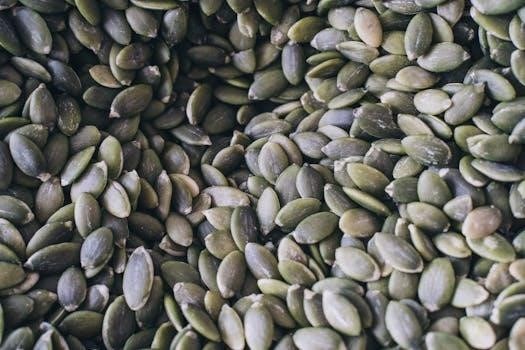acid alkaline food chart pdf
Acid-alkaline food charts are tools that categorize foods based on their potential to produce acid or alkaline conditions in the body after digestion․ These charts are used to promote balanced diets, with a focus on whole foods․
The Concept of Acid and Alkaline Foods
The concept revolves around how foods affect the body’s pH balance, post-digestion․ It’s not about the food’s inherent pH before consumption but rather the residue it leaves․ Some foods create an “acidic ash,” while others produce an “alkaline ash․” Generally, foods that leave an alkaline residue are considered healthy, often consisting of whole, unprocessed items․ The goal is to balance the diet, favoring alkaline-forming foods, especially when the immune system needs support, aiming for an 80% alkaline intake to aid digestion and calm the body’s systems, with the remainder from healthier acid-forming options․
Understanding pH and Food
The pH scale, ranging from 0 to 14, measures acidity or alkalinity․ Foods are categorized based on their post-digestion pH effect, not their pre-consumption pH․ This helps in understanding dietary impacts․
pH Scale and its Relevance to Foods
The pH scale is crucial for understanding how foods affect the body․ It ranges from 0 to 14, with 7 being neutral․ Values below 7 indicate acidity, while those above 7 indicate alkalinity․ The relevance to foods lies in their post-digestion effect, where some acidic-tasting foods can become alkaline, and vice versa, after being processed in the body․ This is due to the mineral content and ash residues after digestion․ The goal is to consume foods that help maintain a balanced internal pH, which contributes to overall health․
The Impact of Food on the Body’s pH
Foods can influence the body’s pH balance, with some creating acidic or alkaline conditions․ This is due to their mineral content, and how they are processed after digestion․
How Digestion Affects pH Levels
Digestion plays a crucial role in determining whether a food will have an acidifying or alkalizing effect on the body․ The process involves breaking down food and leaving an ash residue․ This ash can be either acidic or alkaline, depending on the food’s mineral composition․ Surprisingly, some foods that taste acidic may produce alkaline residues, and vice versa․ The body relies on alkaline minerals to neutralize acid residues to maintain cellular health after digestion․ For example, lemons, despite being acidic, have a high content of alkalizing minerals․
Alkaline-Forming Foods
Alkaline-forming foods are those that leave an alkaline residue in the body after digestion․ These often include many fresh fruits, vegetables, nuts, and legumes, promoting better health․
Examples of Alkaline-Forming Foods
Many vegetables such as spinach, broccoli, kale, and cucumbers are considered highly alkaline-forming․ Fruits like lemons, despite their citric acid content, have an alkalizing effect due to their mineral content․ Other examples include avocados, asparagus, and bell peppers․ Nuts like almonds and chestnuts, as well as legumes including lentils and kidney beans, also fall into this category․ These foods help balance the body’s pH, promoting overall health and well-being․ Incorporating a variety of these items into the diet is beneficial․

Acid-Forming Foods
Acid-forming foods include meat, cheese, eggs, and processed items․ Grains, sugary drinks, alcohol, and refined carbohydrates are also acid-forming․ These foods contribute to a lower pH balance in the body․
Examples of Acid-Forming Foods
Common examples of acid-forming foods include various meats such as beef, lamb, and pork, along with poultry like chicken and turkey․ Dairy products such as hard cheeses, milk, and yogurt also fall into this category․ Processed foods, including fast food burgers and many packaged goods, are typically acid-forming․ Additionally, refined grains like white bread and pasta, sugary beverages, alcohol, and sweets such as cakes and biscuits contribute to acidity․ It’s important to note that not all acid-forming foods are unhealthy, and a balanced diet should include a variety of food types․
Using an Acid-Alkaline Food Chart
To use an acid-alkaline food chart, identify foods as either acid-forming or alkaline-forming․ The goal is to achieve a balanced intake, emphasizing more alkaline choices, and limiting some acid ones․
How to Interpret the Chart
When interpreting an acid-alkaline food chart, understand that it reflects the effect of foods after digestion, not their initial pH․ Foods are categorized based on the ash they leave behind, either acidic or alkaline․ The chart usually lists foods with varying degrees of acid or alkaline potential․ Focus on consuming more from the alkaline side, like vegetables and some fruits, and moderate your intake of acid-forming foods, such as meats and processed items․ This approach helps to balance the body’s pH levels, according to proponents of the diet․ Remember that these charts are for guidance and not medical advice․
Benefits of a Balanced Diet
A balanced diet, including both alkaline and acidic foods, supports overall health by ensuring a wide range of nutrients․ It is essential for optimal bodily functions and well-being․
Importance of Both Alkaline and Acidic Foods
While alkaline diets are often promoted, it’s crucial to understand that the body needs both alkaline and acidic foods for optimal function․ Focusing solely on one side of the spectrum can lead to nutritional deficiencies and imbalances; A balanced approach ensures a wide range of vitamins, minerals, and other essential nutrients․ Including a variety of whole, unprocessed foods from both categories provides the body with what it needs to maintain overall health and well-being․ A balanced diet is not just about avoiding certain foods; it is about achieving a harmonious intake of different types of foods that benefit the body․

Limitations and Considerations
While acid-alkaline food charts offer guidance, they should be used with caution․ Scientific evidence supporting their claims is limited, and individual needs can vary greatly․ Always consult a healthcare professional․
Scientific Evidence and Individual Needs
The scientific community has not fully embraced the claims of the alkaline diet and the direct impact of food on blood pH levels․ The body tightly regulates its pH balance․ While some studies suggest potential benefits, more research is needed․ Individual responses to foods vary, influenced by metabolism, health conditions, and lifestyle․ What works for one person may not work for another․ Therefore, personalized dietary approaches are often necessary, rather than relying solely on a general acid-alkaline chart․ Consulting healthcare professionals is advisable for tailored dietary advice․

Practical Application of the Chart
Integrating the chart involves making informed food choices․ Focus on incorporating more alkaline-forming foods․ It does not suggest eliminating all acid-forming foods․ Balance is key to a healthy diet․
Tips for Incorporating the Information
Start by gradually increasing your intake of alkaline-forming foods, such as leafy greens, vegetables, and certain fruits․ Reduce consumption of highly processed and acid-forming foods like sugary drinks and fast food․ Use the chart as a guide, not a strict rulebook, focusing on variety and whole foods․ Experiment with recipes that combine alkaline and acid-forming foods in balanced meals․ Listen to your body and adjust your diet accordingly․ Remember that individual needs may vary, and it is essential to consult with a healthcare professional or a registered dietitian for personalized guidance․

Printable Acid-Alkaline Food Charts
Many websites offer free printable acid-alkaline food charts․ These resources can be easily downloaded and used as a handy reference for meal planning, often in PDF format․
Where to Find and Download Charts
Numerous websites, including health and wellness blogs, nutrition-focused sites, and alternative health resources, offer printable acid-alkaline food charts․ These are often available as PDF documents for easy downloading and printing․ Look for charts that are well-researched and clearly presented, ensuring the information is accurate․ Some may be found on sites that focus on alkaline diets or holistic health․ Be sure to check the source for credibility before relying on the information provided․ Always use charts as a guide, and consult a healthcare professional or nutritionist for personalized advice․
Acid-alkaline food charts offer a guide to dietary choices, emphasizing whole foods and balance․ While helpful, they should be used with an understanding of their limitations and alongside professional advice․
Acid-alkaline food charts categorize foods by their potential to form acid or alkaline residues in the body after digestion, not by their taste․ The goal is to promote a balanced diet․ Alkaline-forming foods are often whole and unprocessed, while acid-forming foods can include processed items․ These charts should be viewed as a guide, not a rigid rule, as individual needs may vary․ A balanced diet includes both alkaline and acidic elements․ Consulting healthcare professionals is wise when making significant changes to one’s diet based on these charts․











Leave a Comment